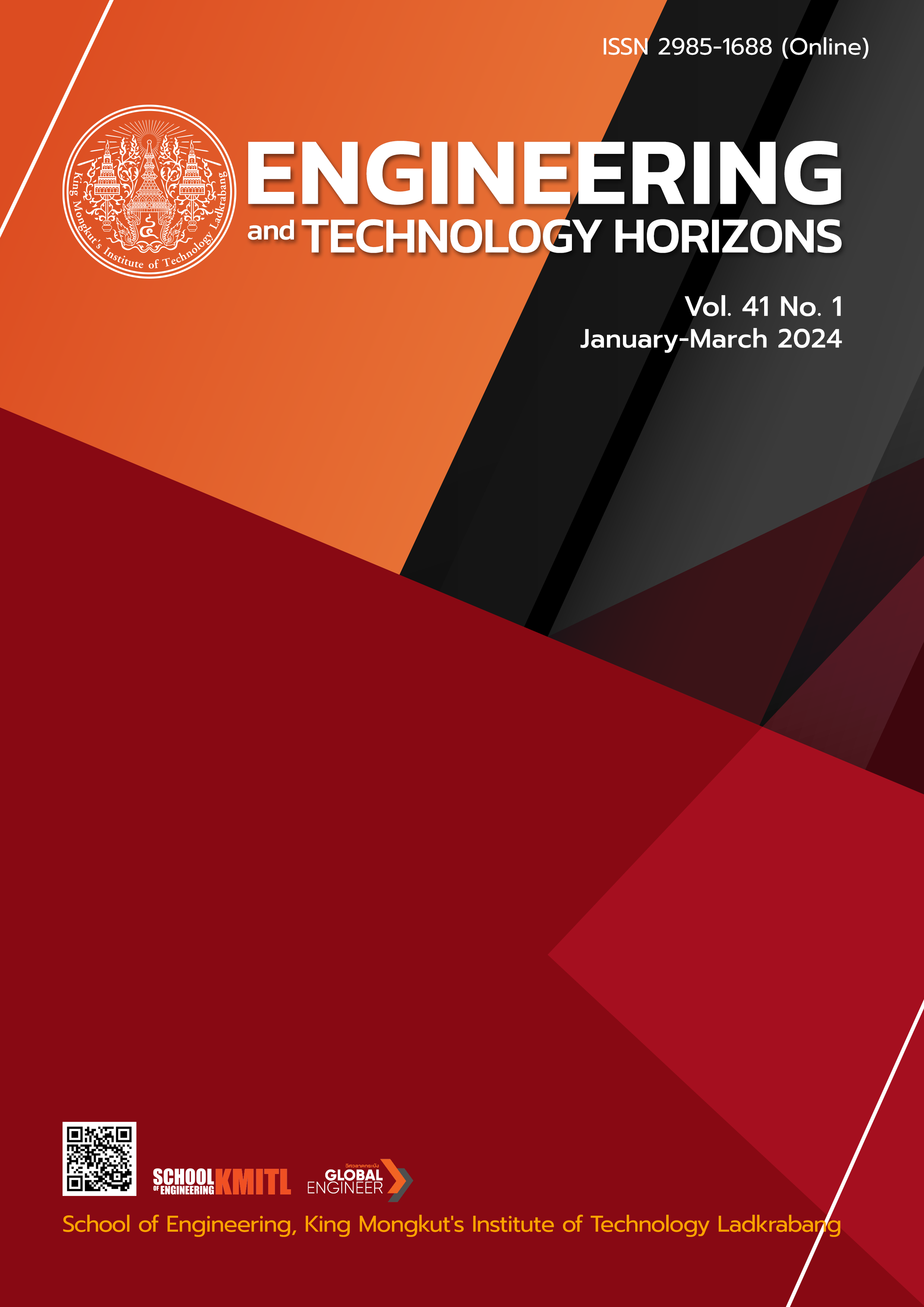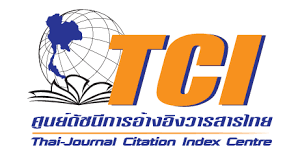Effects of Synthesis Method on Catalytic Activities of Ag/TiO2 Catalyst in CO Oxidation Reaction
DOI:
https://doi.org/10.55003/ETH.410109Keywords:
Silver, Titanium dioxide, CO oxidationAbstract
Supported silver catalysts on titanium dioxide have been synthesized by three different methods to compare catalytic activity in CO oxidation. The catalysts were prepared by the wet impregnation method with 10 mole% of silver. In the first method, the silver catalysts were impregnated on the titanium dioxide nanoparticles (Ag/TNP), while in the second method, the silver catalysts were impregnated on the titanium dioxide nanotubes (Ag/TNT). The third method, the silver catalysts were impregnated on the titanium dioxide nanoparticles before the nanotube process (Ag/TNP-TNT). The Ag/TNP and Ag/TNT catalysts showed highly dispersed silver nanoparticles with an average particle size of less than 5 nm on the surface of titanium dioxide, whereas the Ag/TNP-TNT catalyst exhibited much lower dispersion of silver nanoparticles. The highly dispersed silver on the titanium dioxide resulted in a large number of surface active sites (Ag0). The catalytic activity test found that the Ag/TNT catalysts with the highest number of active sites (2.20 × 1020 atom/g-catalyst) exhibited higher CO oxidation activity than the Ag/TNP and Ag/TNT catalysts with 100% CO conversion at 125°C.
References
S. Dey and G. C. Dhal, “Materials progress in the control of CO and CO2 emission at ambient conditions: An overview,” Materials Science for Energy Technologies, vol. 2, no. 3, pp. 607–623, 2019, doi: 10.1016/j.mset.2019.06.004.
H. Jiang, S. Zhang, X. Bi, W. Ma and Z. Wei, “Proarrhythmic effects of carbon monoxide in human ventricular tissue: insights from computational modeling,” Computers in Biology and Medicine, vol. 140, 2022, Art. no. 105066, doi: 10.1016/j.compbiomed.2021.105066.
Y. Zhao, X. Zhang and Z. Yang, “Efficient capturing and oxidation of CO through bimetallic surface alloying on WC (0001),” Journal of Alloys and Compounds, vol. 844, 2020, Art. no. 156125, doi: 10.1016/j.jallcom.2020.156125.
S. Dey and G. C. Dhal, “Property and structure of various platinum catalysts for low-temperature carbon monoxide oxidations,” Materialstoday Chemistry, vol. 16, 2020, Art. no. 100228, doi: 10.1016/j.mtchem.2019.100228.
E. M. Slavinskaya, A. I. Stadnichenko, J. E. Q. Domínguez, O. A. Stonkus, M. Vorokhta, B. Šmíd, P. Castro-Latorre, A. Bruix, K. M. Neyman and A. I. Boronin, “States of Pt/CeO2 catalysts for CO oxidation below room temperature,” Journal of Catalysis, vol. 421, pp. 285–299, 2023, doi: 10.1016/j.jcat.2023.03.004.
H. C. Song, S. Oh, S. H. Kim, S. W. Lee, S. Y. Moon, H. Choi, S. Kim, Y. Kim, J. Oh and J. Y. Park, “The effect of the oxidation states of supported oxides on catalytic activity: CO oxidation studies on Pt/cobalt oxide,” Chemical Communications, vol. 55, no. 64, pp. 9503–9506, 2019, doi: 10.1039/C9CC03770E.
H. M. Altass, S.A. Ahmed, R.S. Salama, Z. Moussa, R. S. Jassas, R. I. Alsantali, M. M. Al-Rooqi, A. A. Ibrahim, M. A. Khder, M. Morad et al., “Low Temperature CO Oxidation Over Highly Active Gold Nanoparticles Supported on Reduced Grapheme Oxide@Mg-BTC Nanocomposite,” Catalysis Letters, vol. 153, pp. 876–886, 2023, doi: 10.1007/s10562-022-04026-y.
Y. -Q. Su, Y. -Y. Qin, T. Wu and D. -Y. Wu, “Structure sensitivity of ceria-supported Au catalysts for CO oxidation,” Journal of Catalysis, vol. 407, pp. 353–363, 2022, doi: 10.1016/j.jcat.2022.02.008.
V. V. Dutov, G. V. Mamontov, V. I. Zaikovskii, L. F. Liotta and O. V. Vodyankina, “Low-temperature CO oxidation over Ag/SiO2 catalysts: effect of OH/Ag ratio,” Applied Catalysis B: Environmental, vol. 221, pp. 598–609, 2018, doi: 10.1016/j.apcatb.2017.09.051.
E. Kolobova, A. Pestryakov, G. Mamontov, Y. Kotolevich, N. Bogdanchikova, M. Farias, A. Vosmerikov, L. Vosmerikova and V. Cortes Corberan, “Low-temperature CO oxidation on Ag/ZSM-5 catalysts: Influence of Si/Al ratio and redox pretreatments on formation of silver active sites,” Fuel, vol. 188, pp. 121–131, 2017, doi: 10.1016/j.fuel.2016.10.037.
R. M. Al Soubaihi, K. M. Saoud and J. Dutta, “Low-temperature CO oxidation by silver nanoparticles in silica aerogel mesoreactors,” Chemical Engineering Journal, vol. 455, 2023, Art. no. 140576, doi: 10.1016/j.cej.2022.140576.
K. D. Rasamani, “Composite nanostructures as effective catalysts for visible-light-driven chemical transformations,” Ph.D. dissertation, Chemist. Dept., Temple Univ., Philadelphia, PA, USA, 2020.
M. Lamoth, M. Plodinec, L. Scharfenberg, S. Wrabetz, F. Girgsdies, T. Jones, F. Rosowski, R. Horn, R. Schlögl and E. Frei, “Supported Ag nanoparticles and clusters for CO oxidation: Size effects and influence of the silver-oxygen interactions,” ACS Applied Nano Materials, vol. 2, no. 5, pp. 2909–2920, 2019, doi: 10.1021/acsanm.9b00344.
A. F. Zedan, N. K. Allam and S. Y. AlQaradawi, “A Study of Low-Temperature CO Oxidation over Mesoporous CuO-TiO2 Nanotube CATALYSTS,” Catalysts, vol. 7, no. 5, 2017, Art. no. 129, doi: 10.3390/catal7050129.
Y. Sun, Y. Gao, C. He, W. Song, Z. Jiang, R. Albilali and B. Bai, “Efficient and stable low-temperature CO oxidation over Pt/In–SnO2 composite triggered by abundant oxygen vacancies and adsorption sites,” Catalysis Science & Technology, vol. 11, pp. 3762–3774, 2021, doi: 10.1039/D1CY00112D.
N. Comsup, J. Panpranot and P. Praserthdam, “The influence of Si-modified TiO2 on the activity of Ag/TiO2 in CO oxidation,” Journal of Industrial and Engineering Chemistry, vol. 16, no.5, pp. 703–707, 2010, doi: 10.1016/j.jiec.2010.07.015.
M. Abdullah and S. K. Kamarudin, “Influence of highly concentrated sodium hydroxide (NaOH) towards formation of highly ordered TiO2 nanotubes (TNT) structure,” Malaysian Journal of Analytical Sciences, vol. 20, no 6, pp. 1405–1412, 2016, doi: 10.17576/mjas-2016-2006-20.
M. Á. L. Zavala, S. A. L. Morales and M. Ávila-Santos, “Synthesis of stable TiO2 nanotubes: Effect of hydrothermal treatment, acid washing and annealing temperature,” Heliyon, vol. 3, no. 11, 2017, Art. no. e00456, doi: 10.1016/j.heliyon.2017.e00456.
E. Jalali, S. Maghsoudi and E. Noroozian, “A novel method for biosynthesis of different polymorphs of TiO2 nanoparticles as a protector for Bacillus thuringiensis from Ultra Violet,” Scientific Reports, vol. 10, no. 1, 2020, Art. no. 426, doi: 10.1038/s41598-019-57407-6.
R. Camposeco, M. Hinojosa-Reyes, S. Castillo, N. Nava and R. Zanella, “Synthesis and characterization of highly dispersed bimetallic Au-Rh nanoparticles supported on titanate nanotubes for CO oxidation reaction at low temperature,” Environmental Science and Pollution Research, vol. 28, pp. 10734–10748, 2021, doi: 10.1007/s11356-020-11341-7.
M. Mendez-Cruz, J. Ramirez-Solis, and R. Zanella, “CO oxidation on gold nanoparticles supported over titanium oxide nanotubes,” Catalysis Today, vol. 166, no. 1, pp. 172–179, 2011, doi: 10.1016/j.cattod.2010.06.014
B. Zhu, X. Zhang, S. Wang, S. Zhang, S. Wu and W. Huang, “Synthesis and catalytic performance of TiO2 nanotubes-supported copper oxide for low-temperature CO oxidation,” Microporous and Mesoporous Materials, vol. 102, no. 1–3, pp. 333–336, 2007, doi: 10.1016/j.micromeso.2006.11.028.
L. Usgodaarachchi, C. Thambiliyagodage, R. Wijesekera, S. Vigneswaran and M. Kandanapitiye, “Fabrication of TiO2 Spheres and a Visible Light Active α-Fe2O3/TiO2-rutile/TiO2-Anatase Heterogeneous Photocatalyst from Natural Ilmenite,” ACS Omega, vol. 7, no. 31, pp. 27617–27637, 2022, doi: 10.1021/acsomega.2c03262.
A. Rajabi, M. J. Ghazali, E. Mahmoudi, A. H. Baghdadi, A. W. Mohammad, N. M. Mustafah, H. Ohnmar and A. S. Naicker, “Synthesis, Characterization, and Antibacterial Activity of Ag2O-Loaded Polyethylene Terephthalate Fabric via Ultrasonic Method,” Nanomaterials, vol. 9, no. 3, 2019, Art. no. 450, doi:10.3390/nano9030450.
B. Gauri, K. Vidya, D. Sharada and W. Shobha, “Synthesis and Characterization of Ag/AgO Nanoparticles as alcohol sensor,” Research Journal of Chemistry and Environment, vol. 20, no. 10, pp. 1–5, 2016.
J. Fowsiya and G. Madhumitha, “Biomolecules Derived from Carissa edulis for the Microwave Assisted Synthesis of Ag2O Nanoparticles: A Study Against S. incertulas, C. medinalis and S. mauritia,” Journal of Cluster Science, vol. 30, pp. 1243–1252, 2019, doi: 10.1007/s10876-019-01627-3.
G. I. N. Waterhouse, G. A. Bowmaker and J. B. Metson, “The thermal decomposition of silver (I, III) oxide: A combined XRD, FT-IR and Raman spectroscopic study,” Physical Chemistry Chemical Physics, vol. 3, no. 17, pp. 3838–3845, 2001, doi: 10.1039/B103226G.
N. Issei, N. Hidetsugu, H. Toshiyuki and K. Shuichi. “The Thermal Decomposition and Reduction of Silver(I) Oxide,” Bulletin of the Chemical Society of Japan, vol. 47, no. 8, pp. 1827–1832, 1974, doi: 10.1246/bcsj.47.1827.
D. A. Purta, M. A. Portnoff, F. Pourarian, M. A. Nasta and J. Zhang, “Catalyst for the Treatment of Organic Compounds,” U. S. Patent 2004/0077485 A1, Apr. 22, 2004.
Downloads
Published
How to Cite
Issue
Section
License
Copyright (c) 2024 School of Engineering, King Mongkut’s Institute of Technology Ladkrabang

This work is licensed under a Creative Commons Attribution-NonCommercial-NoDerivatives 4.0 International License.
The published articles are copyrighted by the School of Engineering, King Mongkut's Institute of Technology Ladkrabang.
The statements contained in each article in this academic journal are the personal opinions of each author and are not related to King Mongkut's Institute of Technology Ladkrabang and other faculty members in the institute.
Responsibility for all elements of each article belongs to each author; If there are any mistakes, each author is solely responsible for his own articles.






